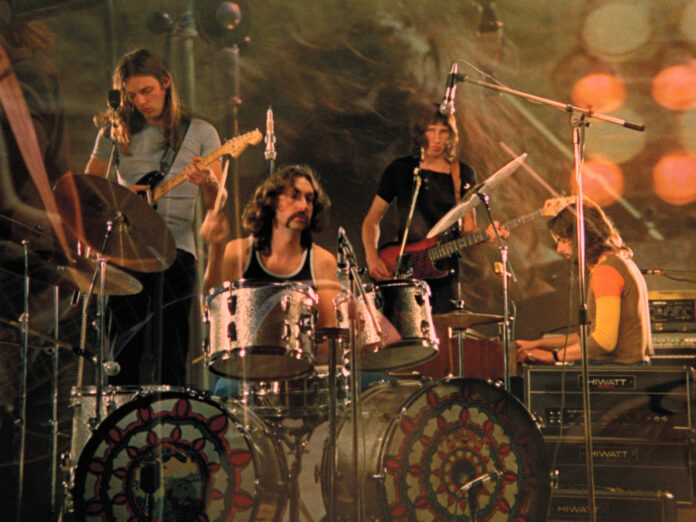Pink Floyd and experimental filmmakers were made for each other. Sketchy plot? Unknowable characters? Third act still in development? In the era immediately after the departure of Syd Barrett, Pink Floyd could certainly empathise with all of that – and for the right fee would be able improvise you some searching and intermittently explosive music to soundtrack it.
Pink Floyd and experimental filmmakers were made for each other. Sketchy plot? Unknowable characters? Third act still in development? In the era immediately after the departure of Syd Barrett, Pink Floyd could certainly empathise with all of that – and for the right fee would be able improvise you some searching and intermittently explosive music to soundtrack it.
It had recently worked for the BBC (the moon landings, 1969) and Barbet Schroeder, for his films More (1968) and La Vallée (1972), but when he approached Pink Floyd, the French director Adrian Maben had arguably left it a little too late to get their full attention for a vaguely outlined project juxtaposing their music with works of surrealist art. By now, after all, Pink Floyd were getting somewhere. The “ping” sound in “Echoes” had lately been a penny audibly dropping on how the band might pilot their way beyond the next horizon with structured, conceptual pieces.
However, when Maben, undeterred, came back with a revised project – to film the band playing a set to the empty amphitheatre in Pompeii in October 1971 – he’d alighted on something sufficiently odd to pique their interest. If he was too late to catch the shifting and ectoplasmic Floyd he thought he wanted, Maben, much in the spirit of the times, captured an era in a way a more dogged documentarian might have missed. He filmed an important band in the way that no such band is generally ever filmed: extensively, in superbly high quality, and – most importantly – just as they were moving into what, for once, it isn’t vulgar to call their imperial phase.
Maben’s direction – now rendered in the gleaming definition of this new release – is all about grandeur. The Pink Floyd: Live At Pompeii footage has some sweet things in it, like the band roaming around the volcanic landscape, communing with the bubbling mud (a visual history of Pink Floyd promo images between 1971 and ’74 would feature a lot of sand) but the main characterand scale of the concert sequences is monumental.
The camera moves in a stately fashion, drinking in the historic setting and charting the build of the set. There are graceful tracking shots of the backs of the amplifiers (“Pink Floyd. London”), which strongly suggest that in the mathematics of the era, gear quantity equalled serious music. This was clearly serious – a fact confirmed by the presence of a grand piano.
Slowly, the band’s set unfolds. The first part of “Echoes”, “Careful With That Axe, Eugene”, “Saucerful Of Secrets”… it’s an engrossing and sumptuous thing to watch, as the band languidly perform this very good music on a sunny afternoon. On one level, it’s a scene of fin-de-siècle pranksterism: they’re here to do something for its own sake; the same benign testing of frontiers that will make you found a school or an underground newspaper. On another, freighted as the scene is with the benefit of hindsight, the film now plays as more thoughtful and bespoke. Pink Floyd. The amphitheatre at Pompeii. Which is the more enduring edifice?
Pink Floyd’s personalities lighten the gravitas. During interviews conducted while making The Dark Side Of The Moon in 1972, we don’t get much of an insight into Rick Wright or the mildly preoccupied David Gilmour. Roger Waters? He’s full of strong opinions on everything, from philosophical questions of instrumental technology (are the Floyd’s machines running themselves?) to the non-sibilant second pressings of Obscured By Clouds. The real gift to the filmmakers, though, is undoubtedly Nick Mason. Looning at the drums, his presence is an asset in live sequences otherwise filled with tranquil guitar noodling and Roger Waters’ occasional flailing at the gong.
Back in the canteen at EMI Studios on Abbey Road, he delivers a historic rebuke to the wheatgrass smoothie (“I’ll have egg, sausage, chips and beans – and a tea”) and is as insightful on the times and Pink Floyd’s place in them as he is dogmatic about the correct slice of fruit crumble (“NOT a corner piece”).
For some people, Mason thinks, Floyd are “part of their childhood”; part of the “underground London” era that included the free concert in Hyde Park. That was all very well, he suggests, but it’s not a place where the band would want to stay forever. In the studio, we observe Rick Wright adding another well-chosen keyboard trill to “Us And Them” and can immediately understand that there’s no danger of that. As the world will shortly come to know, Pink Floyd’s music has already woken up to the concerns of the adult world. What they play from now on will, for good and bad, be filled by the responsibilities of their own maturity.
When you purchase through links on our site, we may earn an affiliate commission. Here’s how it works.



